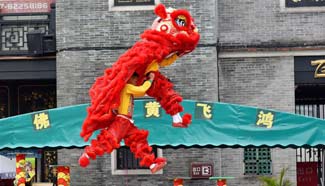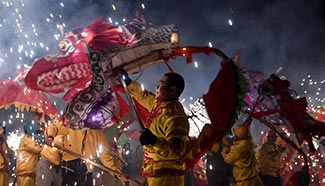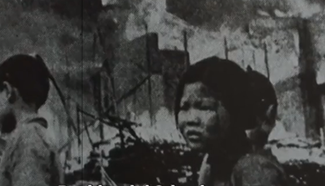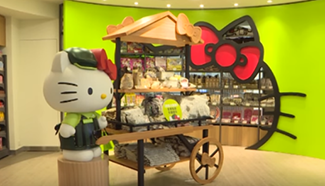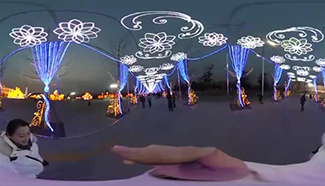by Xinhua writers Yuan Quan, Jia Zhao
BEIJING, Feb. 10 (Xinhua) -- Zhang Kuo, 58, forever associates his art with Chairman Mao Zedong.
In the 1970s, when he was a middle school student, houses and streets in Beijing were posted with woodcut prints of the "great helmsman" during Spring Festival.
He was fascinated by the traditional folk art, but dared not try at that time, because any mistake on the Chairman Mao portrait could incur "anti-revolutionary" accusations.
Forty years later, he is now known as "the last master of Beijing's woodcut New Year prints."
The art - "nianhua" - dates back more than 600 years to when people put woodcut prints on doors and walls, and the gates of palaces, to ward off devils or express good wishes in traditional festivals.
Subjects varied from place to place, but Beijing natives preferred pictures of gods, heroes, ancestors, folk tales and Peking operas.
Zhang's family lived in a hutong alley near the Forbidden City. He learned carpentry, including woodcutting, from a neighbor at a young age, before being employed as a truck driver on road construction projects.
In 2007, he travelled to Shaanxi and Henan provinces, where he found local woodcut print artists still thriving. Zhang was inspired, and determined to return to the craft.
He bought wood and spent months in libraries and antique shops, seeking traditional prints, books, and carving knives. He rented a small house as his studio in a hutong in downtown Beijing.
Woodcut printing has four steps. He usually sketches a picture on a piece of paper before carving it on a set of boards. He paints the boards in different colors. Lastly, he presses a piece of paper to the board to print the picture. In bygone days, the steps were sometimes done by different craftsmen, but Zhang does them all himself.
For a decade, he has spent hours each day carving, often forgetting to eat.
His early work drew little attention. For a long time, he sold two or three paintings a month, each priced just 20 yuan. He earned a living from running a restaurant.
Machine-made prints sell much cheaper and faster, but Zhang is unfazed by the competition. He comforts himself with a Chinese saying: "Soft fire makes sweet malt."
Though woodcut prints bring in little money, he is rewarded with skill, joy and contentment.
In the past, woodcut printing was a low-paid job. Industrialization made the skills rare and the craftsmen more respected. Zhang's story has been covered in newspapers and books, and attracted a lot of attention on social media.
He and his wife are frequently invited to demonstrate at temple fairs and exhibitions. Last year, he was invited to teach at primary and middle schools to inspire the next generation's interest in the traditional art, which was added to China's intangible cultural heritage list in 2006.
He has also tried to bring modern culture into the art, including Chinese and foreign cartoon characters in his work, and printing on shopping bags.
The Monkey King, the map of Middle-earth from "The Lord of the Rings" and popular Japanese cartoon and video game characters are also on his printing list.
His favorite piece of work is a QR code stamp that took three days to carve. He uses it on each print so that customers can scan it and reach him on WeChat.
Zhang never tires of sharing his work and traditional folk art on social media, posting several times a day.
He finished a rooster design before the Lunar New Year, and now is busy carving a portrait of Confucius.
His biggest wish is to hold an exhibition of his prints: "For a craftsman, being respected matters more than making money."

